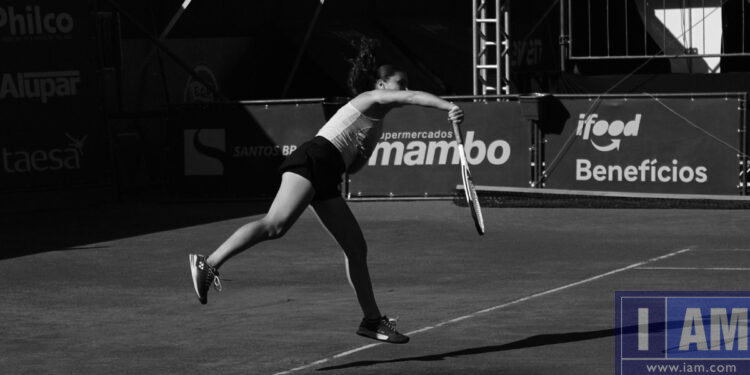I have to admit, some days, like today, I actually prefer the soft feel of a lightweight cotton t-shirt when I’m out for a morning jog. There’s something comforting about that broken in feel. But, this is only the case until I hit about three miles. At that point, the fabric’s wicking abilities are put to the test, and I can count on a few hours of irritated nipples followed by potential blood loss. Every distance runner has to learn that lesson the hard way.
But don’t get me wrong, cotton is not all bad. The comfort to consequence equation changes depending on your activity level and your environment. It was a particularly humid camping trip that really taught me that point and just how important moisture wicking is. Staying dry is not just about athletic performance, it is also about health. I mean, in a muggy environment, you run the risk of heat exhaustion and fungal infections if you don’t stay dry. That experience really opened my eyes for me and it reaffirmed something my tennis coach friend from Mexico has been telling me for ages: in certain climates, technical fabrics are not just a good idea, they are a must.
The Science of Wicking
Moisture wicking works in a couple of ways. It uses capillary action to draw sweat away from your skin via tiny channels in the fabric’s weave, and then it allows that moisture to evaporate quickly into the air through vapor transmission. Cotton, on the other hand, is at a complete disadvantage. It absorbs moisture and holds onto it, which is just miserable whether you’re cooling yourself down too quickly or not at all.
My friend has been telling me about this for ages. And, he’s not just talking about athletic wear. He wears moisture wicking shirts everywhere – to the grocery store, out to dinner, the whole bit. The reason for that is simple: he grew up playing sports in the hot and humid climate of Mexico and learned that synthetic fabrics really aren’t for stodgy elites, they’re for functional comfort. When your daily environment demands that you stay cool all of the time, then the idea of wearing athletic wear every day suddenly makes a lot of sense.
Moisture wicking fabrics are designed to be hydrophobic on the inside and hydrophilic on the outside. This creates a gradient that pulls sweat away from your body and your skin and it helps to regulate your body temperature in the process. This is not just about your comfort this time. This is about you staying safe. When you’re either hot or cold, your body can’t function properly in my opinion, whether you’re competing in a sport or you’re just wandering around your backyard.
Synthetic Options
Polyester is the king of athletic wear for a reason, because it’s hydrophobic, durable, and cheap. Plus, it comes in a variety of different weaves that can be used to create everything from super breathable mesh to tight weaves that provide compression. That’s basically what all those “dri-fit” shirts are made from – the type of fabric my friend has come to swear by for its consistent performance across a range of temperatures. On the other hand, one major downside is that polyester tends to retain a lot of odor – and not just from sweat. It seems that bacteria love to live in those fiber strands and can cause the odor to linger even after you wash the shirt.
Nylon has a number of its own advantages. It’s a lot softer than polyester and it offers superior abrasion resistance, which is a real plus in high friction areas. Think about when you’re running and your cotton t shirt is chafing you all to heck – a little bit of nylon in those areas can make all the difference in the world. You find nylon in hiking gear and anywhere durability is a real concern over moisture management.
Polypropylene is basically the king of moisture transfer. It literally cannot absorb water. However, it does have its downsides – it melts under low temperatures and degrades rather badly in sunlight. This is a real shame because when you do need it – like during a long, cold winter run – it’s brilliant. I reach for it when I’m out camping in the winter – staying dry really isn’t just about comfort in those conditions, it’s about staying alive.
Natural and Hybrid Solutions
Merino wool is basically a revolution in natural athletic fabrics. It regulates temperature, resists odor, and even continues to insulate when it gets wet. Plus, the finer merino (17-19 microns) feels almost as soft as cotton, but outperforms synthetic fabrics in multi-day wear. I’ve been using merino wool for years and I can tell you that one merino shirt can last for days – I can’t say the same for cotton or synthetic fabrics.
Bamboo marketing often gets a little out of control. While bamboo viscose does feel silky and has some antimicrobial properties, its moisture wicking isn’t much better than cotton. There are some mechanically-processed bamboo fabrics that do a better job, but they’re pretty rare and expensive. Most “bamboo” athletic wear is basically just rayon with a few modest benefits.
Synthetic-natural blends are all about getting the best of both worlds. They might be 85% polyester and 15% merino, for example. These blends keep the durability and affordability of synthetic fabrics, while reducing odor. Cotton-polyester blends, on the other hand, should generally be avoided – because the weaknesses of the cotton will always over power the benefits of the polyester.
Choosing Your Fabric
At the end of the day, it’s not always a straightforward choice. For my short easy runs, I can still get away with cotton. But the moment I hit three miles, I know that cotton is no longer an option. For humid environments or all day outdoor exposure, moisture wicking becomes a hygiene issue – it’s not just about performance, it’s about avoiding a range of health issues.
High-intensity, short duration: Go with pure polyester or nylon for maximum moisture transfer and quick drying.
Endurance activities
Merino or merino blends are where it’s at for temperature regulation and odour resistance. You never want to be stuck with cotton on a long run – the bleeding will get the best of you.
Hot, humid climates
I learned this trick from my mexican tennis coach – synthetic moisture-wicking fabrics should be a staple in your wardrobe. Not just for playing tennis, either – they’re perfect for everyday wear.
Multi-day outdoor exposure
If you’re out in the woods for days on end, you want something that’s not going to give you – merino or treated synthetics with antimicrobial properties are pretty much essential. Camping’s a big one for me, and I know a number of people who swear by these fabrics for extended outdoor trips.
Variable conditions
To be honest, if the weather’s going to change from one minute to the next, I just throw a synthetic layer over my merino and hope for the best.
Budget-conscious
If cash is tight, the truth is polyester isn’t a bad choice at all. It’s not the best, but it’ll do the job about 90% as well as the premium stuff for a third of the price
The Comfort Paradox
So here’s the thing Ive learned: what feels good right now and what keeps you going all day aren’t the same thing. You know, that super soft cotton t shirt might feel great for the first mile but after a while synthetic fabrics are the clear winner when it comes to comfort. I met this guy who wore dri-fit all the time – he just got that before I did, prioritising all day comfort over something that feels good for a minute or two.
Listen: fabric tech only works if you’re wearing the right size. Compression fits are great for moisture transfer – that’s because theyre nice and tight – while loose fits are where it’s at for evaporative cooling because you get that nice air going around you. And that’s just it, even a super loose cotton shirt will turn on you the minute it gets wet – but with a loose technical fabric you can still get the benefits.
So the ultimate test? Well its pretty simple – just observe what happens to you in different situations and make a note. that cotton threshold – that’s where you start to feel like you cant go on. below that you can just go for cotton, above it you need to get with the programme. Because lets be real, whether you’re running past that cotton comfort zone, camping in some tropical nightmare or just living everyday with constant moisture management issues – it’s not about being a gear snob, its just being honest about the reality of things.


















